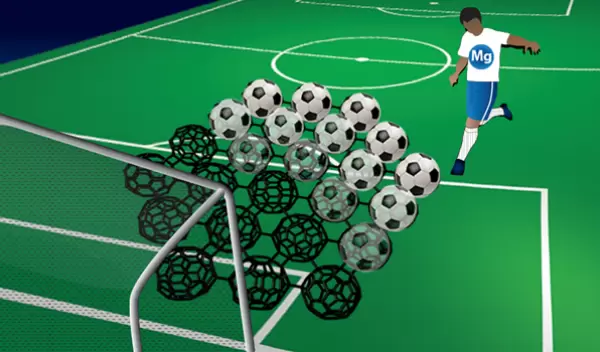
Chemists discover new form of carbon, graphullerene, graphene's 'superatomic' cousin
Carbon in its myriad forms has long captivated the scientific community. In addition to being the primary component of all organic life on Earth, material forms of carbon have earned their fair share of breakthroughs. In 1996, the Nobel Prize in chemistry went to the discoverers of fullerene, a superatomic symmetrical structure of 60 carbon atoms shaped like a soccer ball. In 2010, researchers working with an ultra-strong, atom-thin version of carbon, known as graphene, won the Nobel Prize in physics.
In work published in Nature, researchers led by Columbia University chemists Xavier Roy, Colin Nuckolls and Michael Steigerwald with first author Elena Meirzadeh have discovered a new version of carbon that sits somewhere between fullerene and graphene: graphullerene. It's a new two-dimensional form of carbon made up of layers of linked fullerenes peeled into ultrathin flakes from a larger graphullerite crystal — the same way graphene is peeled from crystals of graphite, the material found in pencils.
The work was supported in part by the U.S. National Science Foundation: a grant to Columbia's NSF-funded Materials Science and Engineering Research Center, and two research grants to Roy.
"It is amazing to find a new form of carbon," said Nuckolls. "It also makes you realize that there is a whole family of materials that can be made in a similar way that will have new and unusual properties as a consequence of the information written into the superatomic building blocks."
Superatoms, a focus of the Materials Science and Engineering Research Center, are clusters of collectively behaving atoms, larger than a molecule but smaller than a crystal. Superatoms can serve as building blocks for all kinds of new materials.
With 60 carbon atoms in the ball to work with, fullerenes can theoretically be linked together in several different ways, each of which could yield different electronic, magnetic and optical properties. This first version represents just one possible configuration, Roy said.
The work is a starting point for the team to explore the potential of graphullerene. From a chemistry perspective, they plan to tweak and tune its modular properties and introduce new structures, while collaborators will look more closely at what happens when graphullerene sheets are combined with different kinds of two-dimensional materials to see what other secrets carbon conceals.
"The discoveries of both graphene and fullerenes were incredibly impactful," said Roy. Fullerenes, for example, are used in medicine as contrast agents for MRI and X-ray imaging and to deliver drug therapies. They're also used to build organic solar cells. The more recently discovered graphene, an extremely light yet strong material with numerous unique properties, is being actively explored for potential uses in electronics, energy applications and more.
"Now we've combined them together into this new form of carbon,” Roy said. “We don't know exactly what will come out of this work, but it will be very exciting to explore.”
